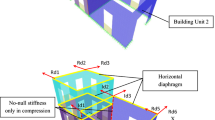Abstract
The results of shaking table tests of a series of 1:5 scale masonry building models have been used for the assessment of values of structural behavior factor q for masonry structures, seismic force reduction factors proposed for the calculation of design seismic loads by Eurocode 8, European standard for the design of structures for earthquake resistance. Six models have been tested, representing prototype buildings of two different structural configurations and built with two different types of masonry materials. The study indicated that the reduction of seismic forces for the design depends not only on the type of masonry construction system, but also on structural configuration and mechanical characteristics of masonry materials. It has been also shown that besides displacement and energy dissipation capacity, damage limitation requirement should be taken into account when evaluating the values of behavior factor. On the basis of analysis of experimental results a conclusion can be made, that the values at the upper limit of the proposed range of values of structural behavior factor q for unreinforced and confined masonry construction systems are adequate, if pushover methods are used and the calculated global ductility of the structure is compared with the displacement demand. In the case where elastic analysis methods are used and significant overstrength is expected, the proposed values are conservative. However, additional research and parametric studies are needed to propose the modifications.
Similar content being viewed by others
References
Alcocer SM, Arias JG, Flores LE (2004) Some developments on performance based seismic design of masonry structures. In: Fajfar P, Krawinkler H (eds) Performance-based seismic design. Concepts and implementation. PEER Report 2004/05. Berkeley, pp 33–44
Benedetti D, Carydis P, Pezzoli P (1998) Shaking table tests on 24 simple masonry buildings. Earthq Eng Struct Dyn 27: 67–122
Bertero V, Uang CM (1992) Issues and future directions in the use of an energy approach for seismic resistant design of structures. In: Fajfar P, Krawinkler H (eds) Nonlinear seismic analysis and design of reinforced concrete buildings. Elsevier, London, pp 3–22
Da Porto F, Grendene M, Modena C (2009) Estimation of load reduction factors for clay masonry walls. Earthquake engineering and structural dynamics, doi:10.1002/eqe.887
Eurocode 8 (2004) Design of structures for earthquake resistance, Part 1: general rules, seismic actions and rules for buildings. EN 1998-1:2004. CEN, Brussels
European Macroseismic Scale 1998 (1998) Grünthal G (ed) European Seismological Commission, Luxemburg
Fajfar P, Kilar V (1992). EAVEK: supplement to version 3.0. Faculty of Civil Engineering and Geodesy, IKPIR: Ljubljana (in Slovene)
Harris GH, Sabnis GM (1999) Structural modeling and experimental techniques. CRC Press, Boca Raton
Housner GW (1959) Behavior of structures during earthquakes. J Struct Division ASCE 85(4): 109–129
Langhaar HL (1951) Dimensional analysis and theory of models. Wiley, New York
Magenes, G (2006) Masonry building design in seismic areas: recent experiences and prospects from a European point of view. In: The first European conference on earthquake engineering and seismology. CD-ROM, Geneva, Keynote Address K9: paper 4009
Moroni MO, Astroza M, Gomez J (1992) Seismic force reduction factors for masonry buildings. In: Proceedings 10th world conference on earthquake engineering, vol.8. Balkema, Rotterdam, pp 4521–4524
Naseer A (2009) Performance behavior of confined brick masonry buildings under seismic demand. Doctoral dissertation, NWFP University of Engineering and Technology, Peshawar
Oetes A, Loering S (2006) On the behavior of masonry buildings subjected to seismic loads. Bautechnik, 83(2): 125–138 (in German)
Tomaževič M (1987) Dynamic modelling of masonry buildings: story mechanism model as a simple alternative. Earthq Struct Dyn 15(6): 731–749
Tomaževič M, Weiss P (1990) A rational, experimentally based method for the verification of earthquake resistance of masonry buildings. In: Proceedings fourth U.S. national conference on earthquake engineering, vol. 2. Earthquake Engineering Research Institute, El Cerrito, pp 349–358
Tomaževič M, Velechovsky T (1922) Some aspects of testing small-scale masonry building models on simple earthquake simulators. Earthq Eng Struct Dyn 21(11): 945–963
Tomaževič M, Weiss P (1994) Seismic behavior of plain and reinforced-masonry buildings. J Struct Eng ASCE 120(2): 323–338
Tomaževič M, Klemenc I (1997) Verification of seismic resistance of confined masonry buildings. Earthq Eng Struct Dyn 26(10): 1073–1088
Tomaževič M (2007) Damage as a measure for earthquake-resistant design of masonry structures: Slovenian experience. Can J Civil Eng 34(11): 1403–1412
Zonta D, Zanardo G, Modena C (2001) Experimental evaluation of the ductility of a reduced-scale reinforced masonry building. Mater Struct 34: 636–644
Author information
Authors and Affiliations
Corresponding author
Rights and permissions
About this article
Cite this article
Tomaževič, M., Weiss, P. Displacement capacity of masonry buildings as a basis for the assessment of behavior factor: an experimental study. Bull Earthquake Eng 8, 1267–1294 (2010). https://doi.org/10.1007/s10518-010-9181-y
Received:
Accepted:
Published:
Issue Date:
DOI: https://doi.org/10.1007/s10518-010-9181-y




